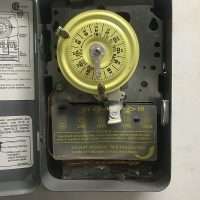Another little problem around the house that can use a little creative circuitry to make it better. Do I really have to do it? No. I do it because I can, and because it is fun!

In Waikoloa solar hot water is an obvious addition to the house, we had it installed within a couple months of moving in. Considering electric power is about $0.40/kWh on the island, and tropical sunlight is quite intense, the use of solar to heat our water has been good money saving move… Long, hot showers with no guilt!
Once or twice a year we will get a period of heavy clouds and the water temperatures will fall to the point we need to turn on the electric back-up heating element in order to have that hot shower. Like most solar setups the storage tank has a electric element that will heat the water when needed.
To control this electric heater the solar technicians installed a modified hot water heater timer circuit to control the back-up electric heater element. This is an electro-mechanical clock that could be set to turn on and off some device at the same times each day. With the turn-on tabs removed the unit will only turn off the heater. You turn it on manually, and then a few hours later it turns off, hopefully after heating the tank to an acceptable temperature. This means you never forget to turn off the electric heater and defeat to whole reason for solar.

The second problem is that you really do not know how long the timer will run. The techs left two turn off tabs on the dial, nominally every twelve hours. The problem is that you really do not know where you are starting within that twelve hours. Switch the unit on and it is hit or miss how much time you get, you can randomly get anything from a few minutes to 12 hours depending on where the tabs are when you hit the switch.
On a whim I decided to put in a better solution. With more than a little experience in electrical control systems this part is easy and fun. A timing relay and an electrical contactor will do the job nicely. Both can be had for $10-20 each on EBay, both can be wired into the same box that held the original mechanical timer.

I simply gutted the timer box, removing the old mechanical timer. I then drilled a few holes to mount the timing relay and the contactor. An hour of wiring later and I had a far better solution!
A push-button on the panel starts the timing relay. One contact of the relay is setup in a latching arrangement, once started the timer remains on until the programmed time runs out, held on by it’s own contacts in place of the push-button switch.
The Omron H3BA-A8 can be programmed for several different operating modes and time periods from a fractions of a second to 100 hours. I set mode E, one shot timer, and a period of ten hours. There are other models of timing relay that will work, you just need to find the right version that can do 6-10 hours.
The same latching contact in the timing relay closes a small AC contactor, this supplies power to the water heater element in the solar storage tank. The water heater has an internal temperature control, heating the water to a set point and cycling the heater to keep it there.

The only installation issue is that the solar techs had not wired the neutral to the timer circuit, thus only 240Vac was available in the box. Not a huge issue as this box is right beside the circuit breaker panel and it only took a few minutes to run a new supply cable with both phases and neutral available for the circuit. If I had a 240Vac rated timer relay and contactor this could have been avoided, just run on 240Vac. I had 120Vac compnents… I ran the neutral.
When off the circuit requires zero power as it is completely disconnected, and will remain so until you hit the push-button again. The indicator light completes the setup, showing that the circuit is on and the timer running.
Just press the button and it works! Contactor fires, switch lights up. and it runs for ten seconds, just as I have the timer programmed for testing. Just reset the timer for hours instead of seconds… Done.


I have a solar water heater and I shut down the electric timer since it is only me and my wife in the house. I assume since the timer is off, the heater is working on solar only. Am I right?
The heater is entirely off unless needed, no power being used. A few dark rainy days and we need a bit of a boost, happens a couple times a year. Just press the button.
I inherited a home with an old solar water heater with a manual electric back up element that works perfect on sunny days. My question is for how long should I turn on the back up on cloudy or rainy days to hot water for 3 adult?
No simple answer here, how fast the water will heat depends on the model of water heater (the size of the tank and the power put out by the heater). You will probably have to just try it, experiment, and find out for yourself.